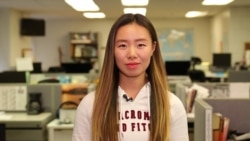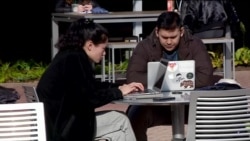Student Union
- By Janssie Zhu
Some Chinese Students Shun the 'Rich' Title

When some college students look at their more than 363, 341 Chinese classmates on American campuses, they think they see internationals who don't have to worry about money.
Viral stories showing international students from China driving high-end cars and waving off concerns about tuition add to the stereotype.
But many Chinese students — who comprise one-third of the more than 1 million international students in the U.S. — say their families saved for years to support an education at expensive American colleges and universities.
"I prepare the tuition and fees by scrimping and saving," said Yeming Zhang, a Chinese parent who spends about $90,000 a year to send her daughter to Boston University in Massachusetts. She said she sold construction industry equipment for 10 years to save for her daughter's schooling.
To lessen the burden on her family, Linda Zhou said she worked 15 hours a week as a receptionist in the English language center and international student center. (Visa restrictions limit where and how much international students can work.)
Many other Chinese students also work to earn money for expenses like food and clothing. Xuemeng Zhao at Hampshire College in Massachusetts works four jobs and sleeps only six hours a day, he said. Vivi Zou from University of California-Davis works as barista for eight hours a week.
About 65 percent of the more than one million international students in the U.S. pay tuition and fees out of pocket, meaning from parents, personal business, or scholarships from their home governments. Among undergraduates, more than 80 percent pay their school costs from personal or family sources, according to the Institute for International Education (IIE) in Washington.
Many are from middle-class or upper middle-class families paying tuition that can range from about $27,000 to more than $70,000 per year for non-Americans. When they apply for student visas, they must show proof that they can afford their annual expenses, not just the airplane ticket to the U.S.
"International students with F-1, F-2, J-1, J-2, and G-series [diplomatic] visas are required to show proof of enough resources to meet their expenses while attending University of Michigan-Ann Arbor, and federal regulations limit financial assistance," explained Rick Fitzgerald, spokesperson for the University of Michigan-Ann Arbor.
Despite the price, many Chinese families prepared for their children's college educations for years and consider their children worthy of a good education.
"I think attending U.S. college provides my son a more extensive platform to expand his horizons and social circles," said Mingjun Chao, whose child attends the University of Southern California. "We paid the bill from our savings."
Likewise, said Yeming Zhang, "I sent my kid to U.S. colleges to get exposed to diverse culture, and to adjust to the diverse society."
WATCH: International Students in America
But when Chinese students arrive in the U.S., they learn they are paying much more than most domestic students, and some question the disparity.
"It's understandable for domestic students to have lower tuition than international students," said Tianze Liu, a Chinese student at the University of California-Irvine. "They deserve the public service of their own country.
"However, sometimes our tuition is 10 times more than theirs."
Dan Mann, associate provost for enrollment management from University of Illinois at Urbana-Champaign, explained that "rates are often higher for international students because they do not pay federal or state taxes that help to fund the university operations and research enterprise."
For example, a student from Massachusetts will pay in-state tuition at the University of Massachusetts, but out-of-state rates to a public university in California, like an international student. At the University of California system in 2016-2017, tuition and fees for in-state residents was $15,397, and $43,411 for out-state residents.
And over the past 30 years, costs increased 213 percent at U.S. public institutions and 130 percent at private U.S. institutions, said Rajika Bhandari, research and strategy senior adviser at IIE. This continued climb in tuition and fees is intersecting with a decrease in public funding for colleges and universities.
State funding for public two- and four-year colleges last year was nearly $9 billion below its 2008 level, reports the Center for Budget and Policy Priorities, a nonpartisan research and policy institute in Washington, on its website.
"A decade since the Great Recession hit, state spending on public colleges and universities remains well below historic levels, despite recent increases," the CBPP wrote.
International students contributed $42 billion to the U.S. economy in 2017-2018, according to the Institute for International Education, in the sectors of higher education, accommodations, dining, retail, telecommunications, transportation and health insurance. And they help support more than 455,000 jobs in the U.S., which means every seven international students create three jobs in the U.S.
Sandy Baum, an expert on higher-education finance at the Urban Institute, a nonprofit research organization, said Chinese students "are not paying more than the full sticker price."
"And they are not paying more than the education is worth to them. At most private colleges, all students are being subsidized — including the Chinese students. It's just that the full-pay students are getting smaller subsidies than those on financial aid."
A few Chinese students reported receiving financial aid from U.S. colleges. Alex Kong, a rising senior from University of Missouri-Columbia School of Journalism, said he received $7,600 over three years, including scholarships and financial aid.
"It's very encouraging to me. It pushes to me devote more time into my academics," he said. "I applied for financial aid and scholarship to relieve my family's burden. It is also the first step for me to be financially independent."
Kong searched Google to learn how to get aid from his college and followed the steps to complete forms. However, "many of my friends don't seem to know about the aid and the scholarship. If you yourself don't ask about it, nobody will tell you," Kong said.
Chinese students say they feel compelled to earn the tuition back through well-paying jobs after graduation.
"I would be happier and feel less pressure if it is not my parents paying for my full tuition. I feel guilty to make them do so," said Linda Zhou, a Chinese senior at Vanderbilt University in Tennessee. "The tuition is like my parents' investment in me, and I have to make it reward and paid back. I will be disappointed in myself if I fail to do so. It's important."
Zhou said she prioritized college rankings over financial aid when she decided on colleges.
"I didn't know enough about financial aid and scholarship when I applied for U.S. colleges. But if I could choose again, I would apply for financial aid and scholarship, and attend the one who gives me money even though it might be ranked lower," she said.
See all News Updates of the Day
- By VOA News
Competition grows for international students eyeing Yale

It’s tough to gain admission to Yale University, and it’s getting even tougher for international students as standout students from around the world set their sights on Yale.
The Yale Dale News, the campus newspaper, takes a look at the situation here.
- By VOA News
Student from Ethiopia says Whitman College culture made it easy to settle in

Ruth Chane, a computer science major from Ethiopia, writes about her experiences settling into student life at Whitman College in the U.S. state of Washington.
"The community at Whitman College made sure I felt welcomed even before I stepped foot on campus," she says.
- By VOA News
Claremont Colleges student gets a shock when she heads home to Shanghai

In The Student Life, the student newspaper for the Claremont Colleges, a consortium of five liberal art colleges and two graduate schools in Claremont, California, student Rochelle Lu writes about readjusting to her Shanghai home after spending a semester in the United States.
- By VOA News
Cedarville University aims to ease transition for international students

Cedarville University in the U.S. state of Ohio says it’s got more than 140 international students representing 44 countries.
Here, the school interviews Jonathan Sutton, director of international student services. He talks about his job and the opportunities for international students on campus.
- By VOA News
Morehouse College offers prospective students tips on applying and thriving

Morehouse College, a private, historically Black liberal arts college in the U.S. state of Georgia, offers a guide for international students interested in attending the school.
Among the tips to apply and thrive at Morehouse:
- Take advantage of the school’s orientation program
- Turn to the school’s Center for Academic Success for tutoring, support and more
- Immerse yourself in campus life via clubs and societies
- By Reuters
US reviews Columbia University contracts, grants over antisemitism allegations

The administration of President Donald Trump said on Monday it will review Columbia University's federal contracts and grants over allegations of antisemitism, which it says the educational institution has shown inaction in tackling.
Rights advocates note rising antisemitism, Islamophobia and anti-Arab bias since U.S. ally Israel's devastating military assault on Gaza began after Palestinian Hamas militants' deadly October 2023 attack.
The Justice Department said a month ago it formed a task force to fight antisemitism. The U.S. Departments of Health and Education and the General Services Administration jointly made the review announcement on Monday.
"The Federal Government's Task Force to Combat Anti-Semitism is considering Stop Work Orders for $51.4 million in contracts between Columbia University and the Federal Government," the joint statement said.
The agencies said no contracting actions had been taken yet.
"The task force will also conduct a comprehensive review of the more than $5 billion in federal grant commitments to Columbia University."
The agencies did not respond to requests for comment on whether there were similar reviews over allegations of Islamophobia and anti-Arab bias.
Columbia had no immediate comment. It previously said it made efforts to tackle antisemitism.
College protests
Trump has signed an executive order to combat antisemitism and pledged to deport non-citizen college students and others who took part in pro-Palestinian protests.
Columbia was at the center of college protests in which demonstrators demanded an end to U.S. support for Israel due to the humanitarian crisis caused by Israel's assault on Gaza. There were allegations of antisemitism and Islamophobia in protests and counter-protests.
During last summer's demonstrations around the country, classes were canceled, some university administrators resigned and student protesters were suspended and arrested.
While the intensity of protests has decreased in recent months, there were some demonstrations last week in New York after the expulsion of two students at Columbia University-affiliated Barnard College and after New York Governor Kathy Hochul ordered the removal of a Palestinian studies job listing at Hunter College.
A third student at Barnard College has since been expelled, this one related to the occupation of the Hamilton Hall building at Columbia last year.
Canada’s immigration overhaul signals global shift in student migration
From Europe to North America, nations are tightening their immigration policies. Now Canada, long seen as one of the world's most welcoming nations, has introduced sweeping changes affecting international students. The reforms highlight a growing global trend toward more restrictive immigration policies. Arzouma Kompaore reports from Calgary.
Trump administration opens antisemitism inquiries at 5 colleges, including Columbia and Berkeley

The Trump administration is opening new investigations into allegations of antisemitism at five U.S. universities including Columbia and the University of California, Berkeley, the Education Department announced Monday.
It's part of President Donald Trump's promise to take a tougher stance against campus antisemitism and deal out harsher penalties than the Biden administration, which settled a flurry of cases with universities in its final weeks. It comes the same day the Justice Department announced a new task force to root out antisemitism on college campuses.
In an order signed last week, Trump called for aggressive action to fight anti-Jewish bias on campuses, including the deportation of foreign students who have participated in pro-Palestinian protests.
Along with Columbia and Berkeley, the department is now investigating the University of Minnesota, Northwestern University and Portland State University. The cases were opened using the department's power to launch its own civil rights reviews, unlike the majority of investigations, which stem from complaints.
Messages seeking comment were left with all five universities.
A statement from the Education Department criticized colleges for tolerating antisemitism after Hamas' Oct. 7, 2023, attack on Israel and a wave of pro-Palestinian protests that followed. It also criticized the Biden administration for negotiating "toothless" resolutions that failed to hold schools accountable.
"Today, the Department is putting universities, colleges, and K-12 schools on notice: this administration will not tolerate continued institutional indifference to the wellbeing of Jewish students on American campuses," said Craig Trainor, the agency's acting assistant secretary for civil rights.
The department didn't provide details about the inquiries or how it decided which schools are being targeted. Presidents of Columbia and Northwestern were among those called to testify on Capitol Hill last year as Republicans sought accountability for allegations of antisemitism. The hearings contributed to the resignation of multiple university presidents, including Columbia's Minouche Shafik.
An October report from House Republicans accused Columbia of failing to punish pro-Palestinian students who took over a campus building, and it called Northwestern's negotiations with student protesters a "stunning capitulation."
House Republicans applauded the new investigations. Representative Tim Walberg, chair of the Education and Workforce Committee, said he was "glad that we finally have an administration who is taking action to protect Jewish students."
Trump's order also calls for a full review of antisemitism complaints filed with the Education Department since Oct. 7, 2023, including pending and resolved cases from the Biden administration. It encourages the Justice Department to take action to enforce civil rights laws.
Last week's order drew backlash from civil rights groups who said it violated First Amendment rights that protect political speech.
The new task force announced Monday includes the Justice and Education departments along with Health and Human Services.
"The Department takes seriously our responsibility to eradicate this hatred wherever it is found," said Leo Terrell, assistant attorney general for civil rights. "The Task Force to Combat Anti-Semitism is the first step in giving life to President Trump's renewed commitment to ending anti-Semitism in our schools."
- By VOA News
STEM, business top subjects for international students

The Times of India breaks down the most popular subjects for international students to study in the U.S.
STEM and business lead the pack. Read the full story here. (January 2025)
- By VOA News
Safety and visa difficulties among misconceptions about US colleges

U.S. News & World report addresses some of the misconceptions about U.S. colleges and universities, including the difficulty of getting a visa.
Read the full story here. (January 2025)
- By VOA News
Work opportunities help draw international students to US schools

US News & World Report details the three top factors in foreign students' decision to study in the U.S. They include research opportunities and the reputation of U.S. degrees. Read the full story here. (December 2024)
- By VOA News
British student talks about her culture shock in Ohio

A British student who did a year abroad at Bowling Green State University in Ohio talks about adjusting to life in America in a TikTok video, Newsweek magazine reports.
Among the biggest surprises? Portion sizes, jaywalking laws and dorm room beds.
Read the full story here. (December 2024)
- By VOA News
Harvard's Chan School tells international students what to expect

Harvard's T.H. Chan School of Public Health reaches out to international students by detailing the international student experience at the school.
Learn more about housing, life in Boston and more here.
- By Reuters
China unveils plan to build 'strong education nation' by 2035

China issued its first national action plan to build a "strong education nation" by 2035, which it said would help coordinate its education development, improve efficiencies in innovation and build a "strong country."
The plan, issued Sunday by the Communist Party's central committee and the State Council, aims to establish a "high quality education system" with accessibility and quality "among the best in the world."
The announcement was made after data on Friday showed China's population fell for a third consecutive year in 2024, with the number of deaths outpacing a slight increase in births, and experts cautioning that the downturn will worsen in the coming years.
High childcare and education costs have been a key factor for many young Chinese opting out of having children, at a time when many face uncertainty over their job prospects amid sluggish economic growth.
"By 2035, an education power will be built," the official Xinhua news agency said, adding that China would explore gradually expanding the scope of free education, increase "high-quality" undergraduate enrolment, expand postgraduate education, and raise the proportion of doctoral students.
The plan aims to promote "healthy growth and all-round development of students," making sure primary and secondary school students have at least two hours of physical activity daily, to effectively control the myopia, or nearsightedness, and obesity rates.
"Popularizing" mental health education and establishing a national student mental health monitoring and early warning system would also be implemented, it said.
It also aims to narrow the gap between urban and rural areas to improve the operating conditions of small-scale rural schools and improve the care system for children with disabilities and those belonging to agricultural migrant populations.
The plan also aims to steadily increase the supply of kindergarten places and the accessibility of preschool education.
- By VOA News
A look at financial aid options for international graduate students in US

The Open Notebook, a site focusing on educating journalists who cover science, has complied a list of U.S. graduate program financial aid information for international students.










